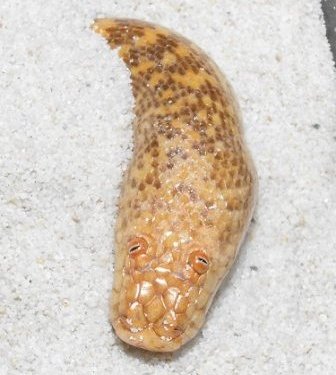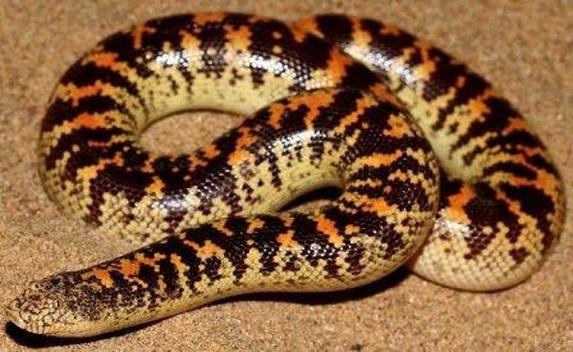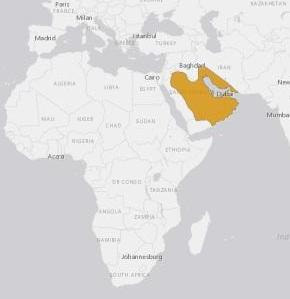Arabian Sand BoaEryx jayakari |

Custom Search
|
|
The Arabian sand boa (Eryx jayakari) also know as Jayakar's sand boa is a harmless boa species endemic to the deserts of the Arabian Peninsula and southern Iran. The species geographic range includes eastern Saudi Arabia, Yemen, Oman, and Kuwait.
In Iran, only a small number of specimens have been recorded in several Provinces including Khuzistan Province, Bushehr Province, and Kerman Province, Like on other snake types there's sexual dimorphism in this species with females being larger than the males. Even so, the Arabian sand boa is a small snake with a stout round body, that grows to a total length of 15 or 16 inches (40 cm). The Arabian sand boa overall coloration is very similar to that of the Kenyan Sand Boa. They have a black or brownish pattern covering a sandy-brown, orange, yellowish-grey or yellow background.
Although they do have a more refined and irregular pattern with the darker blotches sometimes forming irregular bands across the back of the snake. Their underside is whitish or yellowish in color.
While in parts of their range some specimens are much darker in coloration and also almost patternless. They have a blunt, wedge-shaped snout with their very small eyes located on the top of the head, enabling them to remain hidden in the sand and still see around them. Due to the high temperatures of their desertic habitat during the day the Arabian sand boa is largely a nocturnal species. But it is very tolerant to a wide range of temperatures since at night the temperatures drop quite a bit in the desert. During the day these snakes bury themselves quite deep in the sand or soft soil.They live mostly underground only moving towards the surface at dusk and during the night to ambush passing prey. It wasn't until recently that this beautiful snake species has become more available in the exotic pet trade. This was due mostly to the fact that not many specimens were exported and the few available have been rather problematical in captivity. Since feeding mice to these small snakes in captivity proved to be quite a frustrating process. Subspecies / Taxonomy / Etymology There are no subspecies currently recognized by scientists. The species-specific name, jayakari is in honor of Atmaram S. G. Jayakar (1844–1911), an Indian surgeon and naturalist. This also reflects on one of their common names Jayakar's sand boa. Diet / Feeding The Arabian sand boa preys mostly on small reptiles like worm lizards (amphisbaenians) or geckos, which they can easily swallow whole. They are nocturnal foragers and ambush predators and when the unsuspecting prey comes near, it strikes, coiling its muscular body around its victim and tightening its grip until the animal dies. This behavior is very similar to that of their much bigger cousins such as the Boa constrictor. Reproduction
This is an oviparous species which makes them quite odd among boas since they are one of a few species of boa that lays eggs since most boas give birth to live young. Furthermore, it is the only member of the genus Eryx known to lay eggs, which may suggest that the Arabian sand boa belongs in its own genus or subgenus. Females lay a small clutch of 4 to 12 eggs which hatch in about two months at a temperature of 33 °C (91 °F). Conservation / Threats The Arabian sand boa was listed by the IUCN as a "Least Concern" species back in 2012. This mainly due to the fact that it has very wide range, and are still common in at least some parts of their range, and there are no particular threats to the species. They are presumed to have a large population, and the species is unlikely to be declining fast enough to be listed in a more threatened category. Even though the Arabian sand boa has been recorded in the pet trade, this isn't considered to be a major threat. The species is listed on Appendix II of CITES. These snakes are also found in some protected areas in both Saudi Arabia and Kuwait.
|
Scientific classification |
© 2014 Snake Facts About Us | Privacy Policy | Contact





